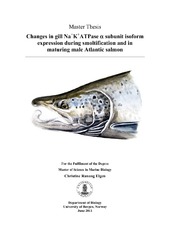Changes in gill Na+K+ATPase alfa subunit isoform expression during smoltification and in maturing male Atlantic salmon
Master thesis
Permanent lenke
http://hdl.handle.net/1956/5145Utgivelsesdato
2011-06-22Metadata
Vis full innførselSamlinger
Sammendrag
Distinct freshwater and seawater chloride cells have been identified in salmon gills and recent studies also suggest that there are specific freshwater (α1a) and seawater (α1b) isoforms of the α subunit of Na+K+-ATPase (NKA). Salmon smolts adjust to seawater prior to migration and an upregulation of NKAα1b transcription have been seen while the smolts were still in freshwater. Studies of mature Pacific salmon (Oncorhynchus spp.) suggest that mature salmon adapt to freshwater while still in seawater and may thus loose the ability to hypo-osmoregulate. Consequently, maturing salmon kept in net pens may suffer from terminal dehydration and this might be a major fish welfare problem in aquaculture as many salmon mature before slaughter weight is achieved. Thus, the aim of the present study is to detect possible changes in gill NKAα1a and gill NKAα1b expression in maturing male salmon kept in fresh- and seawater using Real-Time RT-qPCR. Pre-smolts were exposed to a smolt inducing photoperiod, before half were transferred to seawater, while the rest remained in freshwater. The post-smolts were then exposed to either continuous light or short day photoperiod to induce high end low incidence of mature males, respectively. The present study is the first in which changes in salinity specific NKAα1a and NKAα1b isoforms is used to detect a possible preparatory adaptation to freshwater in maturing male Atlantic salmon. Our date coincides with previously seen changes in NKAα1a and NKAα1b in relation to smoltification and desmoltification as the expression of NKAα1b increased in smolts prior to seawater transfer and NKAα1a expression decreased. Furthermore, an increase in NKAα1a was seen in desmolting salmon while NKAα1b expression declined. These findings support the hypothesis of NKAα1b as the seawater adaptive isoform and NKAα1a as the freshwater isoform. In addition, an increase in NKAα1a were seen in maturing male salmon kept in seawater and NKAα1a levels were significantly higher in mature males than in immature females. No significant differences in NKAα1b were seen between mature males and immature females in seawater, but NKA activity was significantly lower in mature males than in immature females in seawater. This suggest that mature salmon adapt to freshwater while still in seawater and may consequently die from elevated plasma osmolality if kept in seawater after the onset of maturation.
